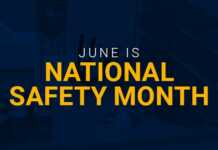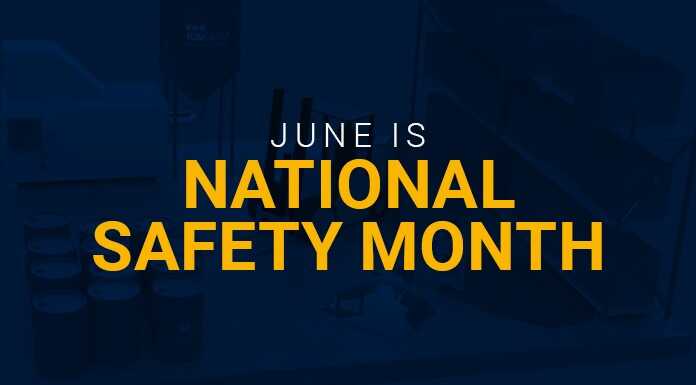Each June, we celebrate National Safety Month to highlight workplace risks, training resources, and tools to help ensure the safety of ICW Group insureds and their workers.
The most common types of workplace accidents are easily preventable with employee training, education, and general awareness. This month, during National Safety Month, take a moment to learn about common risks that are leading drivers for workers’ compensation claims and OSHA compliance violations. As your work comp partner, we’ve got resources to help you and your crews stay safe and injury free.
Five Common Workplace Risks
ONE – Slips, Trips, and Falls
Slips, Trips, and Falls are the second leading driver of claims costs for ICW Group workers’ compensation policyholders and a major general liability risk. There are many steps employers can take to prevent slips, trips, and falls, including choosing the correct floor matting, using proper floor cleaning techniques and enforcing employees to wear slip-resistant footwear in working areas. Check out our four-part Safety in Action training video series to help people stay on their feet.
Our online resource, Safety OnDemand®, also has safety tips and tools to help prevent these injuries. Safety OnDemand is available for free to ICW Group work comp policyholders. Registration is required.
- Slips, Trips, Falls Prevention Training Video
- Slips, Trips, Falls Prevention E-Course
- Slips, Trips, Falls Prevention Safety Meeting Guide
TWO – Struck By or Against
Struck by and against is another top risk exposure for ICW Group policyholders and is typically a leading cause of job injury year over year. According to OSHA, struck by is defined as injuries produced by forcible contact or impact between the injured person and an object or piece of equipment. These types of occupational injuries are prevalent in the construction industry. A worker can be struck by a flying, falling, swinging, or rolling object. Here are a few Safety OnDemand training resources to help.
- Struck By Object Intervention Assessment
- Struck By Caught Between – Spanish language Safety Talk
- Struck By Prevention for Forklift Operators
THREE – Hazard Communications
Hazardous chemicals are a leading cause of workplace injuries and illnesses, with more than 190,000 illnesses and 50,000 deaths occurring annually due to chemical exposures. Having an up-to-date Hazard Communication (HazCom) program keeps employees safe and prevents costly fines and workers’ compensation claims. It’s also a Federal OSHA requirement.
You may be asked for a written HazCom plan during an OSHA inspection. To help ensure you’re compliant, we’ve created a 12-Step Employer’s Guide to Developing a HazCom Plan for your business. The comprehensive guide walks you through the steps needed to get your business on the path to compliance. In the guide, you’ll find:
- Detailed instructions on how to build a HazCom plan for your business
- Templated form to inventory your hazardous materials
- Customizable plan that you can edit and use as your own
- Training tools for employees
FOUR – Lockout Tagout
OSHA states that compliance with its Lockout Tagout procedure standard prevents an estimated 120 fatalities and 50,000 injuries each year. It also prevents costly fines and workers’ compensation claims. Ensure you have a program in place to keep your employees safe.
Lockout Tagout refers to procedures used to properly shut down or disable machinery not in use. We all know machinery can be dangerous when in use, but hazards also exist when you are not using your equipment. That’s why OSHA requires a formal Lockout Tagout program.
To help, ICW Group created a 9-step Lockout Tagout Employer’s Guide for your business. The comprehensive guide walks you through the steps needed to get your business on the path to compliance. In the guide, you’ll find:
- Information on sources of hazardous energy
- Types of Lockout Tagout solutions
- Basic steps and procedures to follow
- Employee training Tools
FIVE – Forklifts
Operating forklifts and other Powered Industrial Trucks (PIT) can be dangerous if you do not take the correct precautions. According to OSHA, 70% of accidents can be prevented with proper training. If you’ve got forklift or PIT operators on your crew, sign up for our forklift train-the-trainer class with a live instructor. During this 4-hour class, you will learn how to train, evaluate, and certify your forklift operators as specified by OSHA’s Powered Industrial Truck standard. You will be actively engaging in instructor-led training activities and interacting with other students. A certification of completion is provided to participants who pass a comprehension written exam. Sign up for the forklift train-the-trainer class here.
Additional resources available on Safety OnDemand include:
- Forklift Operator Training Video
- Daily Checklist – Electric Forklift
- Daily Checklist – Gas or LPG Forklift
- Forklift Hazard Assessment Form
.jpeg )
Utilize these resources and the thousands more available to prevent injury and work comp claims. Sign in or register now to Safety OnDemand to enhance your safety program.

















